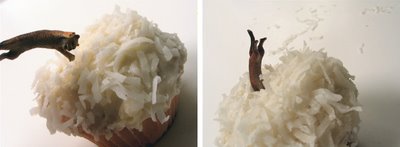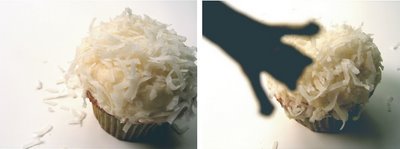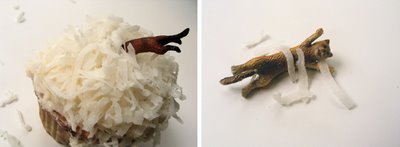I think I know what a man feels like when he picks up his mail-order bride at the post-office and she turns out to be ugly. Oh, the disappointment.
Last month I ordered some bucatini pasta from Italy and gleefully awaited its delivery for at least a week. Much like a young man eagerly expecting his mail-order bride, I dreamt of the many days we would share together, my bucatini and me.
I prepared my home for my new bride by clearing away a cozy spot in the kitchen cabinet and buying her pretty things would make her happy in her new home. I even purchased an isight camera so that she could keep in touch with her family back in Naples.
I had it all planned out. The first of our many special moments together was going to be Pasta YiaYia, a dish on which I have gorged myself countless times at Lula Cafe. Drenched in browned butter, strewn with crumbled feta and crispy browned garlic, then sprinkled with cinnamon, Pasta YiaYia is an uncommon yet magnificent combination of ingredients.
The bucatini at Lula Café is delicate and willowy, its light, hollow strands softly bending across each other, loosely gathering the feta and the garlic in their folds. I was so anxious for my package to arrive so I could make this beautiful pasta! Alas, my giggles of anticipatory delight were stifled when I opened up the delivery box. My bucatini was neither willowy nor delicate, but instead stocky and sturdy. It was nothing but glorified spaghetti. Glorified, fat, hollow spaghetti.
mail-order bucatini that is unfortunately less lovely than the bucatini at Lula Café
I disgustedly cast the lackluster bucatini aside and moped for days (not to be confused with mopped for days). Was I being superficial by not graciously accepting this pasta into my life based on its appearance alone? Probably I was, so I decided to try to make Pasta YiaYia and see if this un-glamorous bucatini could possibly live up to my expectations.
Turns out I’m not superficial and I actually am a good judge of character based on appearance alone. My mail-order bucatini did not compare to the bucatini at Lula Café. The flavors were indeed magnificent, but the shape and texture of the bucatini did not resemble the fragile tangle of pasta presented at Lula's.
Perhaps the imported pasta of which I still have 2 pounds left is the real bucatini, and Lula Café’s bucatini is only a variant. Perhaps the next time I am dining at Lula I shall sneak into the kitchen and determine their source. And if they make their own bucatini, perhaps I shall ask the manager if I could prettyplease purchase a small quantity of such lovely pasta. My pursuit of Pasta YiaYia remains unfinished.
Does anyone want 2 pounds of bucatini from Naples?
Pasta YiaYia
~adapted from Lula Cafe.
¾ lb. bucatini
6 tablespoons butter
1 head garlic, each clove sliced very thinly crosswise (slices will be petal-shaped)
4-6 oz. feta cheese, crumbled
½ teaspoon cinnamon (Café Lula uses Moroccan cinnamon, I only had regular cinnamon)
Boil pasta in salted water until al dente.
While pasta is cooking, heat butter over medium-high heat in a heavy-bottomed saucepan. Just as the butter turns to turn golden-brown, add the garlic slices. Continue to cook the garlic and the butter until the butter is browned and the garlic turns dark golden-brown and crispy. Remove from heat. Do not overcook the garlic or it will taste bitter.
With a slotted spoon, remove the garlic slices and set aside.
Drain the pasta and add to the butter.
Add the cinnamon to the noodles. Stir until noodles are coated with butter and cinnamon.
Plate the pasta on individual plates.
Divide the feta and the garlic slices evenly between the plates.
Sprinkle with additional cinnamon, if desired.











